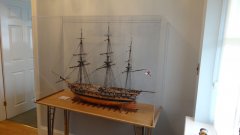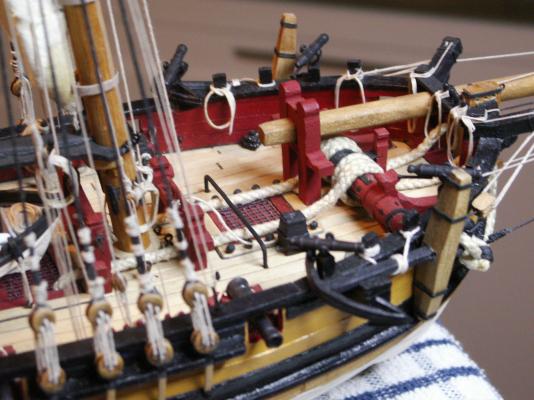-
Posts
866 -
Joined
-
Last visited
About Stockholm tar
- Birthday 10/16/1949
Profile Information
-
Gender
Male
-
Location
Stockholm
-
Interests
Ship modelling, history and maritime history, reading, gentle walking and cycling for exercise (my ME/CFS permitting!), our four cats.
-
 Tumblehome reacted to a post in a topic:
Conway Anatomy of the Ship series. A discussion.
Tumblehome reacted to a post in a topic:
Conway Anatomy of the Ship series. A discussion.
-
 catopower reacted to a post in a topic:
Which Gorch Foch - Mantua/Occre
catopower reacted to a post in a topic:
Which Gorch Foch - Mantua/Occre
-
 Obormotov reacted to a post in a topic:
HMS Victory by guraus - scale 1:48 - plank on frame
Obormotov reacted to a post in a topic:
HMS Victory by guraus - scale 1:48 - plank on frame
-
 FrankWouts reacted to a post in a topic:
HMS Pegasus by Landlubber Mike - Amati/Victory Models - Scale 1:64
FrankWouts reacted to a post in a topic:
HMS Pegasus by Landlubber Mike - Amati/Victory Models - Scale 1:64
-
Hey There Kester .. Just a quick note to see how you are, missing your wonderful Sherbourne updates.
All The Very Best
Eamonn
-
 Hank reacted to a post in a topic:
British official Report of the Prince de Neufchatel vs Endymion battle
Hank reacted to a post in a topic:
British official Report of the Prince de Neufchatel vs Endymion battle
-
 Hank reacted to a post in a topic:
British official Report of the Prince de Neufchatel vs Endymion battle
Hank reacted to a post in a topic:
British official Report of the Prince de Neufchatel vs Endymion battle
-
 Hank reacted to a post in a topic:
British official Report of the Prince de Neufchatel vs Endymion battle
Hank reacted to a post in a topic:
British official Report of the Prince de Neufchatel vs Endymion battle
-
 Jonny 007 reacted to a post in a topic:
Sherbourne by Stockholm tar - Caldercraft - 1/64
Jonny 007 reacted to a post in a topic:
Sherbourne by Stockholm tar - Caldercraft - 1/64
-
Captain Al, I'm not sure about this, but the gaff on the mizzen mast may have been left more or less permanently hoisted. Most of the illustrations I have seen of 18th/19th cent. men of war have them aloft when at anchor and the gaff sail was brailed into the mast, it being loose-footed along the boom. Since the Bounty was rerigged when she was purchased, I imagine she would have followed naval practice in this too. The gaff probably had throat and peak halliards, but there may have been an extra span from the spar to the mast to take it's weight. The vangs would have secured the gaff from movement at its outer end. In passing, there would have been a topping lift to take the weight of the boom when the sail was not set, even though it is not shown on your plans. The peak halliard and vangs would only be of use when the gaff was in the hoisted position and would not have had any control of the boom, not being connected to it. I would think there was a crutch to hold the boom end, when the sail was not set. Hope this helps, but I am sure someone else may have the definitive answer.
-
 Stockholm tar reacted to a post in a topic:
HM Cutter Cheerful 1806 by Chuck - FINISHED - 1:48 scale - kit prototype
Stockholm tar reacted to a post in a topic:
HM Cutter Cheerful 1806 by Chuck - FINISHED - 1:48 scale - kit prototype
-
Endless, I agree, they are not and this is sometimes how such models are displayed – although there are many other such models with the rigging belayed to pins. In reality even in port with the sails furled, the rigging would normally still be belayed to its pin.
- 1,051 replies
-
- cheerful
- Syren Ship Model Company
-
(and 1 more)
Tagged with:
-
Ropes on deck at sea are not usually feasible. To begin with, in any rough weather and has been mentioned, lines adjacent to each other would get tangled together, which is not a good idea, and there is the fact that they could potentially cause accidents, tripping etc. Then there is the damp problem. A wet rope on deck hold moisture far longer than one hung up and even modern ropes will disintegrate eventually through rot. The only real place for running rigging is for it to be belayed on its designated pin. From my own experience, the only time I have seen a large part of the 'spagetti' on deck is when the ship is tacking, wearing, or carrying out some other sail evolution. At most other times, the lines are coiled and tidily hung from their pins out of the way and ready for use Regarding the coils themselves, they are normally coiled on deck in an oval shape to begin with, and even hemp ones will sag under their own weight. Chuck, the coil in your first photo seems very small and not the normal size for most running rigging. Perhaps it was for some special purpose? To me, the coils shown on the models seem not to reflect the way things were done at sea, where all the above would apply, but rather perhaps a modelmakers convention. At that scale, perhaps they couldn't all be belayed in their proper places.
- 1,051 replies
-
- cheerful
- Syren Ship Model Company
-
(and 1 more)
Tagged with:
-
 Stockholm tar reacted to a post in a topic:
Length of horse rail for foresail sheet on English Revenue Cutter
Stockholm tar reacted to a post in a topic:
Length of horse rail for foresail sheet on English Revenue Cutter
-
Tony, I've just spotted your post re. the horse, where you mention my effort! As you say, I had some difficulty in placing it. I seem to remember that I had to put it far enough forward so as not to impede the foremost guns, far enough aft to make it possible for the hatch to be lifted, and high enough for it to clear the anchor cable. Something of a tall order, but I think I made a reasonable compromise! Your height of 15" would seem about right. I also made it what I considered a suitable length, about 4cm, although I guess it could have been a little more. My reasoning was that the deck is cramped enough as it is and the sail could, within reason, be let out further with the sheet running through the blocks attached to the horse. Chuck's drawings were interesting, I had not seen those before. Here's the photo of my horse:
-
 Stockholm tar reacted to a post in a topic:
HMS Victory Bow Cross-section by bryanc - FINISHED - Panart - 1:78 scale
Stockholm tar reacted to a post in a topic:
HMS Victory Bow Cross-section by bryanc - FINISHED - Panart - 1:78 scale
-
 Stockholm tar reacted to a post in a topic:
HMS Victory Bow Cross-section by bryanc - FINISHED - Panart - 1:78 scale
Stockholm tar reacted to a post in a topic:
HMS Victory Bow Cross-section by bryanc - FINISHED - Panart - 1:78 scale
-
 Stockholm tar reacted to a post in a topic:
HMS Victory Bow Cross-section by bryanc - FINISHED - Panart - 1:78 scale
Stockholm tar reacted to a post in a topic:
HMS Victory Bow Cross-section by bryanc - FINISHED - Panart - 1:78 scale
-
 Stockholm tar reacted to a post in a topic:
HM Cutter Alert 1777 by catopower – FINISHED - Shipyard - 1/96 scale - CARD
Stockholm tar reacted to a post in a topic:
HM Cutter Alert 1777 by catopower – FINISHED - Shipyard - 1/96 scale - CARD
-
 Stockholm tar reacted to a post in a topic:
HM Cutter Alert 1777 by catopower – FINISHED - Shipyard - 1/96 scale - CARD
Stockholm tar reacted to a post in a topic:
HM Cutter Alert 1777 by catopower – FINISHED - Shipyard - 1/96 scale - CARD
-
 Stockholm tar reacted to a post in a topic:
HMS Pegasus 1776 by Mirabell61 - FINISHED - scale 1:64 - 16-gun sloop
Stockholm tar reacted to a post in a topic:
HMS Pegasus 1776 by Mirabell61 - FINISHED - scale 1:64 - 16-gun sloop
-
Hi Nils, No, it was always going to be a half model. I had thought of a full hull model, but at the rate I work, I thought that a half model wouldn't take so long! It would also be rather interesting. One day perhaps. Hope your not too disappointed?
-
Nils, You're Pegasus is looking superb – but then I expected nothing less – and love your 'maritime museum' with all those lovely models.
-
 Stockholm tar reacted to a post in a topic:
HMS Pegasus 1776 by Mirabell61 - FINISHED - scale 1:64 - 16-gun sloop
Stockholm tar reacted to a post in a topic:
HMS Pegasus 1776 by Mirabell61 - FINISHED - scale 1:64 - 16-gun sloop
-

need opinions on furled sails
Stockholm tar replied to keelhauled's topic in Masting, rigging and sails
Re. the furled sails of Columbia and Cuauhtemoc, posted by Tadeusz, some foreign training ships tend to display their sails like this at Tall Ships events. The skipper of a vessel I was on asked one of their captains, at one of these events, why they left them like this and he said that it was because it looked 'artistic'. Our skipper thought it looked untidy and unseamanlike and believed that the sails should have been given a proper 'harbour stow.' I have to say that I agree – there's nothing more pleasing than a well stowed sail. Frankie is quite right about their actual stowing, although I would point out that the wind is also a factor in the way they are furled. I have stowed a few sails in my time and the mate, or whoever is in charge, was usually at pains to furl the sail properly, especially at sea where the wind can get into the sail and open it all out. Sometimes the crew would have to do it all over again, if he wasn't satisfied, and many of them had bruised knuckles afterwards! -

Corel's SM23 HMS Victory kit question...
Stockholm tar replied to rivdvm's topic in Wood ship model kits
Teal 2, The bowsprit angle is 30° from the horizontal, according to the book 'Anatomy of Nelson's Ships' by Nepean Longridge. This is quite an old book now, but still a valuable source of information about the Victory, since it was written from his scratch build of the ship for the Science Museum in London. (I have seen it several times and it is superb, although I'm not sure it is on display now.) The book would be useful for the rest of your build and you should be able to get it fairly cheaply, if you look around. -
Joel, You're right, she had. Robin, You make some valid points, especially with regard to the spritsail. I wonder if Stanfield had perhaps seen the Victory when the davits weren't fitted, eg. in a refit, since they would likely be removed at such a time – or did he just overlook them? I'm sure you understand very well the artistic mind.
-
How about this painting by Geoff Hunt? It shows the Victory, followed by the Temeraire and Neptune, heading towards the enemy line at Trafalgar. You'll note the Victory has quarter davits, but the other two ships do not so is it that Victory, being the flagship, has the latest innovations yet to be fitted to other ships? Incidentally, it looks like all Geoff Hunt's paintings of Victory, circa 1805, show the davits. In passing, I would imagine he has done his homework: http://www.artmarine.co.uk/nelsoncollection.aspx
-
It would appear, from various sources, that quarter davits appeared on the larger ships of the line from around 1800. I can't find any definite reference as to when those on the Victory were introduced but McKay, in his AOTS book 'The 100 Gun Ship Victory', gives a date of 1803 in his inventory of the ship's boats. This included the two cutters launched from quarter davits, so they would certainly seem to be there prior to Trafalgar. Regarding the positioning of the stern kedge anchor Harland, in his 'Seamanship', says they were generally stowed in the main and mizzen channels, although McKay says that the Victory had one stowed in the starboard mizzen channel. (He doesn't, however, say how.)
-
Pat, Your assumption, regarding the design for the jack and that in the ensign, is correct. The diagonal St Patrick's cross was not incorporated into the Union flag until 1801, when Ireland became part of the Union of Great Britain. When added the cross was offset from the centre of the white diagonal – indeed the jack as we know it was designed so as to not upset, as far as possible, the sensibilities of the other nations of the Union. I'm not sure it worked 100%!
-
Mike, Good advice from Frankie. It's easy enough to overlook the mast hoops, which is what I did on my Sherbourne – forgetting them completely, instead concentrating on gluing the crosstrees, trestletrees and topmast and then stepping complete mast into the hull. Having calmed down (both in self and language ) I decided the only thing to do was make them out of metal (they were originally to be wood). I used an easily bendable aluminium strip, each cut off hoop first being painted a suitable wood colour and formed into a round shape slightly larger than the mast. These were then opened just enough to pass around the mast, before being closed up and attached to the sail. As with most problems, there is usually a way around it.
-
Captain Al, Catharpins are the lines which cross the ship from one side of the lower shrouds to the other, level with the lower end of the futtock shrouds running to the edge of the top. They were normally attached to a bar, the futtock stave, on each side. You can just see them in the top pic in Shihawke's last post, just below and behind the main yard. I believe their purpose was to tighten in the upper part of the shrouds, so that the lower yards could be braced further.
- 413 replies
About us
Modelshipworld - Advancing Ship Modeling through Research
SSL Secured
Your security is important for us so this Website is SSL-Secured
NRG Mailing Address
Nautical Research Guild
237 South Lincoln Street
Westmont IL, 60559-1917
Model Ship World ® and the MSW logo are Registered Trademarks, and belong to the Nautical Research Guild (United States Patent and Trademark Office: No. 6,929,264 & No. 6,929,274, registered Dec. 20, 2022)
Helpful Links
About the NRG
If you enjoy building ship models that are historically accurate as well as beautiful, then The Nautical Research Guild (NRG) is just right for you.
The Guild is a non-profit educational organization whose mission is to “Advance Ship Modeling Through Research”. We provide support to our members in their efforts to raise the quality of their model ships.
The Nautical Research Guild has published our world-renowned quarterly magazine, The Nautical Research Journal, since 1955. The pages of the Journal are full of articles by accomplished ship modelers who show you how they create those exquisite details on their models, and by maritime historians who show you the correct details to build. The Journal is available in both print and digital editions. Go to the NRG web site (www.thenrg.org) to download a complimentary digital copy of the Journal. The NRG also publishes plan sets, books and compilations of back issues of the Journal and the former Ships in Scale and Model Ship Builder magazines.






